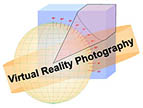

![]() Ask the VR Photography Experts
Ask the VR Photography Experts
![]()
Q: I understand that a "Fish Eye" lens gives you an image in the shape of a circle, with 180 degrees up & down and 180 degrees side to side. What is a "full frame" fish eye?
![]()
A: All lenses give you an image in the shape of a circle. It's just that most lenses make that image circle larger than the camera's frame or format, so that the image captured on film fills the entire frame.
True fisheye lenses project their entire image circle *within* the film frame, as is the case with the 8mm fisheyes (for 35mm format cameras). Lens manufacturers design these lenses so that the image circle projected onto the film plane is small enough to include everything the lens sees - the entire image circle. That's why you see a circular image on the film.
A "full-frame fisheye", such as the 16mm Nikkor, has the same sort of curved "distortion" (straight lines appear as curves, unless they pass through the exact center of the lens) as the 8mm fisheye, except the projected image circle of this "full frame" fisheye is larger than the camera's frame or format. Thus, the fisheye image fills more than the frame, as is the case of most non-fisheye lenses. A 16mm fisheye provides close to 180 degrees of coverage, but only across the diagonal of the frame, because the rest of the image circle is cropped off by the frame edges.
The disadvantage of a full frame fisheye is that you do lose some of the full hemisphere coverage that you have with a true fisheye such as the 8mm. However, the full frame fisheye (16mm) provides a higher resolution (magnification) per degree of view for the fov that it DOES cover -- much as a 100mm lens does over a 50mm lens.
- Scott Highton